There’s something about a farmhouse bathroom that instantly makes you feel at home. Maybe it’s the worn wood vanity that looks like it came from a century-old barn, or the vintage faucet with character you just can’t find at modern hardware stores. Whatever draws you in, these spaces manage to blend practical function with a warmth that’s hard to resist.
If you’ve been scrolling through endless bathroom ideas wondering how to bring that country charm into your own home, you’re in the right place. Farmhouse style isn’t about perfection. It’s about creating a space that feels lived-in, authentic, and just a little bit imperfect in the best possible way.
The beauty of country bathroom decor is its flexibility. You don’t need a sprawling rural property or unlimited budget to pull it off. A few key elements – some weathered textures, natural materials, and vintage-inspired fixtures – can transform even the smallest powder room into something special.
1. Classic White Shiplap Walls

Shiplap has become synonymous with farmhouse style, and honestly? There’s a good reason why. Those horizontal planks add instant architectural interest without overwhelming a small bathroom. The gaps between boards create subtle shadow lines that give flat walls dimension and character.
You can install real wood shiplap or opt for easier-to-work-with MDF versions that come pre-primed. Either way, a fresh coat of white paint brightens the space while letting the texture do the talking. Some people stress about getting the gaps perfectly uniform, but slight variations actually add to the authentic, handcrafted feel.
Consider running shiplap just halfway up the wall as wainscoting if full coverage feels like too much. This works especially well in bathrooms with lower ceilings, where you want to maintain some vertical breathing room.
2. Freestanding Clawfoot Tub
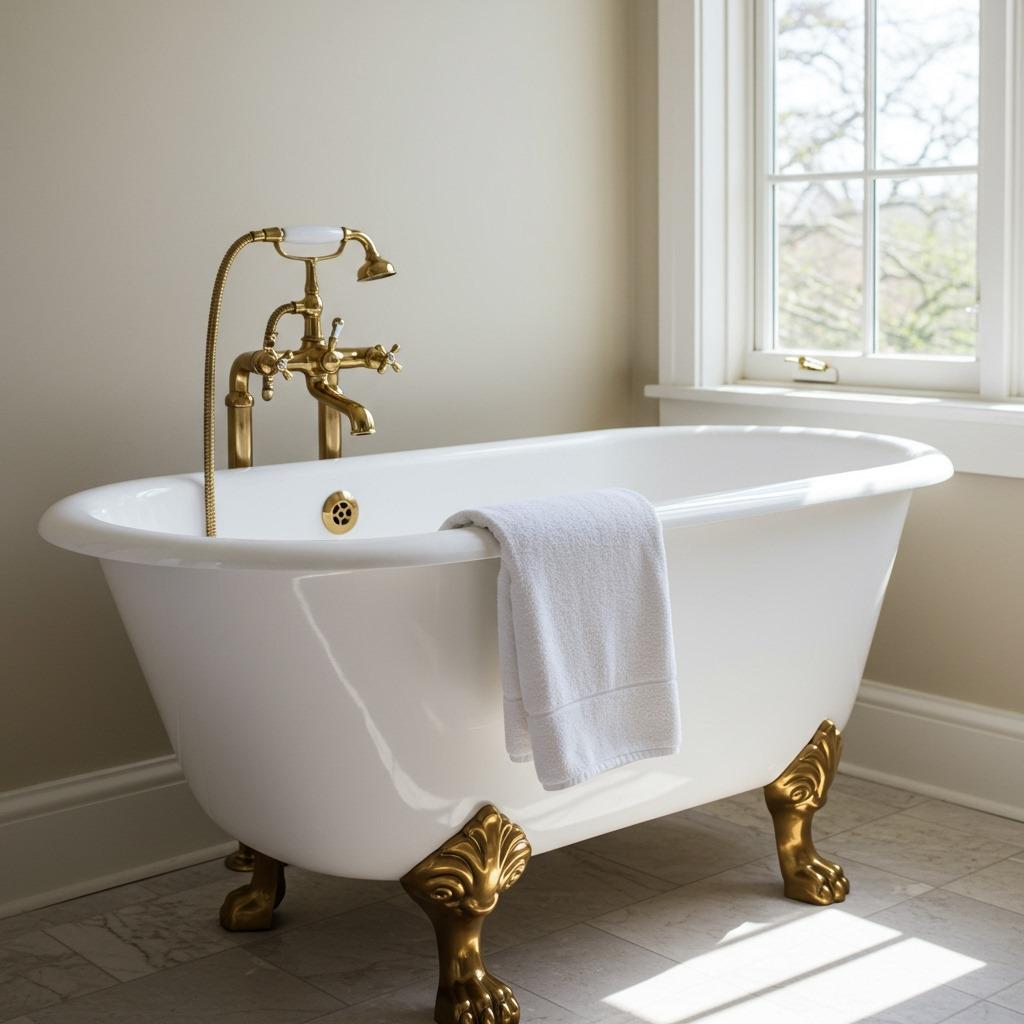
Nothing says “take your time” quite like a clawfoot tub sitting right in the middle of the bathroom floor. These iconic fixtures instantly transport you to a simpler era when baths were an event, not just a quick rinse before bed. The elevated design on decorative feet creates visual lightness despite the tub’s substantial presence.
You’ll find clawfoot tubs in cast iron (heavy, classic, retains heat beautifully) or acrylic (lighter, easier to install, more affordable). Both work perfectly in farmhouse spaces. The feet themselves come in different styles – ball and claw is traditional, but simpler bun feet feel more understated and modern-farmhouse.
Placement matters more than you might think. Positioning your tub near a window creates that dreamy bathing-with-a-view situation that makes you actually want to use it. Just make sure you’ve got good privacy solutions in place, whether that’s frosted glass, plantation shutters, or strategically placed greenery.
3. Apron-Front Farmhouse Sinks
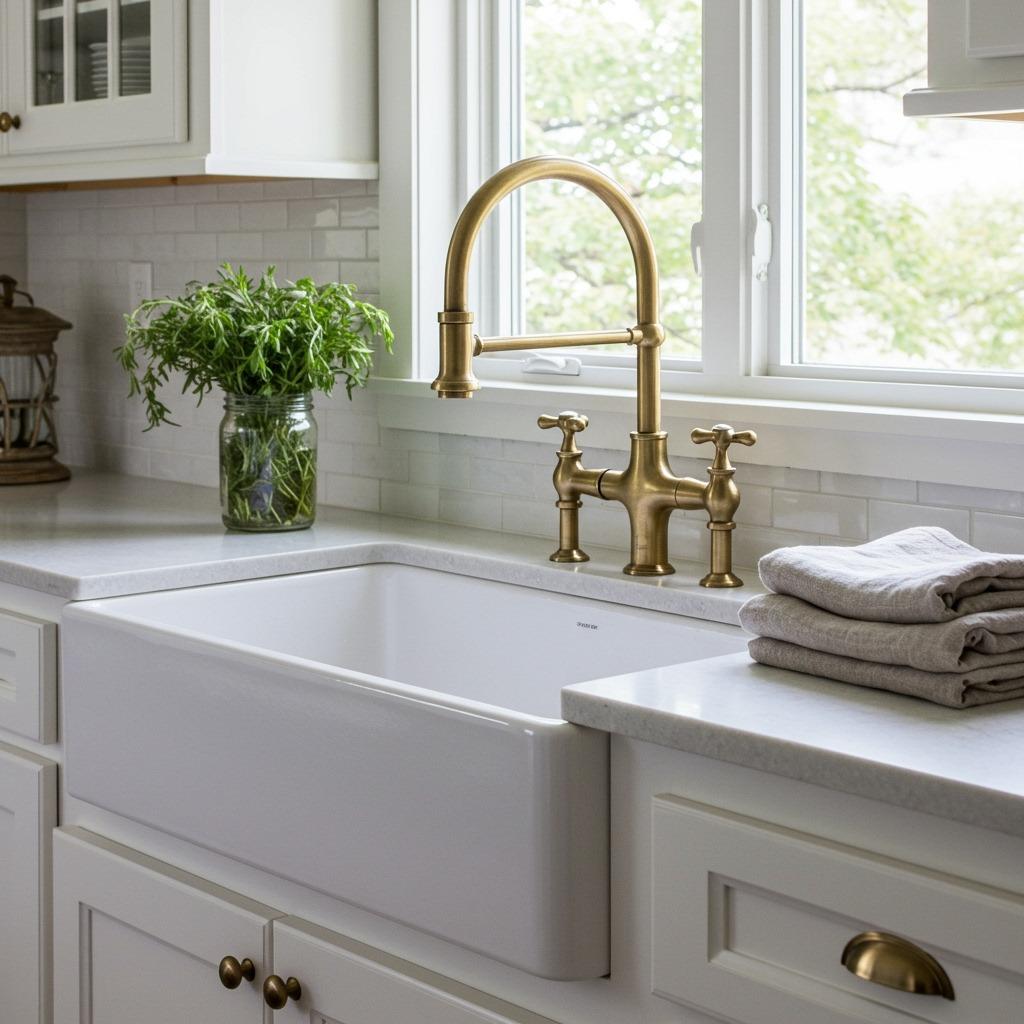
Farmhouse sinks aren’t just for kitchens anymore. That deep basin and exposed front panel bring the same practical beauty to bathroom spaces, especially in larger master baths where you’ve got counter space to work with. The extra depth means less splashing when kids are brushing teeth or when you’re washing your face with a little too much enthusiasm.
These sinks make a statement, so you’ll want to plan your vanity design around them. The apron front should sit flush with or slightly proud of your cabinet face for that authentic look. Materials range from classic white porcelain to warmer fireclay options, though porcelain’s crisp finish tends to feel more traditionally farmhouse.
Pair your sink with the right faucet. A bridge-style faucet with cross handles or a simple gooseneck design complements the vintage aesthetic without competing for attention. Modern chrome can work, but oil-rubbed bronze or unlacquered brass adds warmth that feels more historically appropriate.
4. Reclaimed Wood Vanity
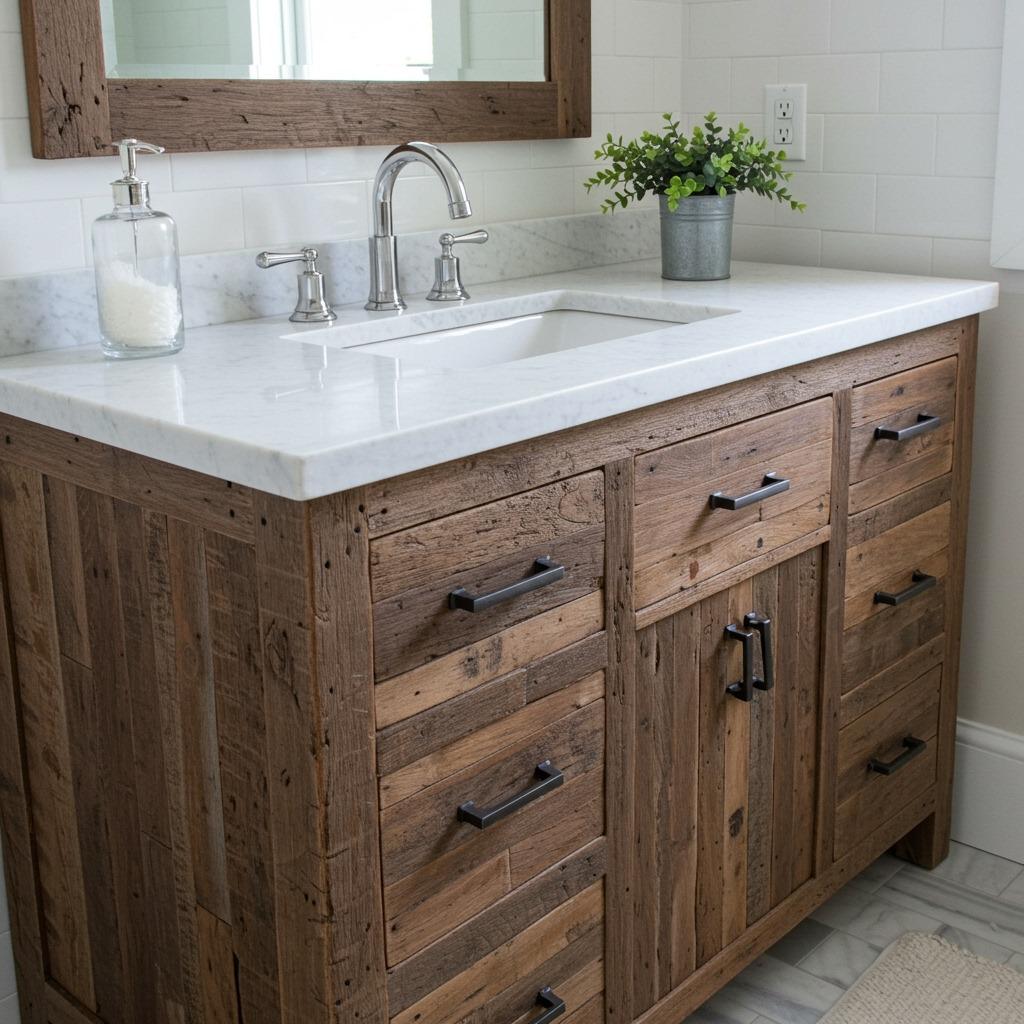
There’s something irreplaceable about wood that’s already lived a full life before landing in your bathroom. Reclaimed wood vanities bring texture, history, and a grounding earthiness that new materials simply can’t replicate. Each board tells its own story through nail holes, saw marks, and color variations earned over decades of use.
Building a custom vanity from salvaged wood is totally doable if you’re handy, or you can find ready-made options from artisans who specialize in reclaimed furniture. The key is proper sealing. Bathrooms are humid environments, so your beautiful weathered wood needs several coats of water-resistant polyurethane or a specialized bathroom-grade finish.
Don’t worry if the wood tones aren’t perfectly uniform. That variation is the whole point. Mix lighter and darker planks for visual interest, or keep things more monochromatic if your bathroom already has a lot going on. Either approach works as long as the wood feels authentic and substantial.
5. Vintage Metal Accents
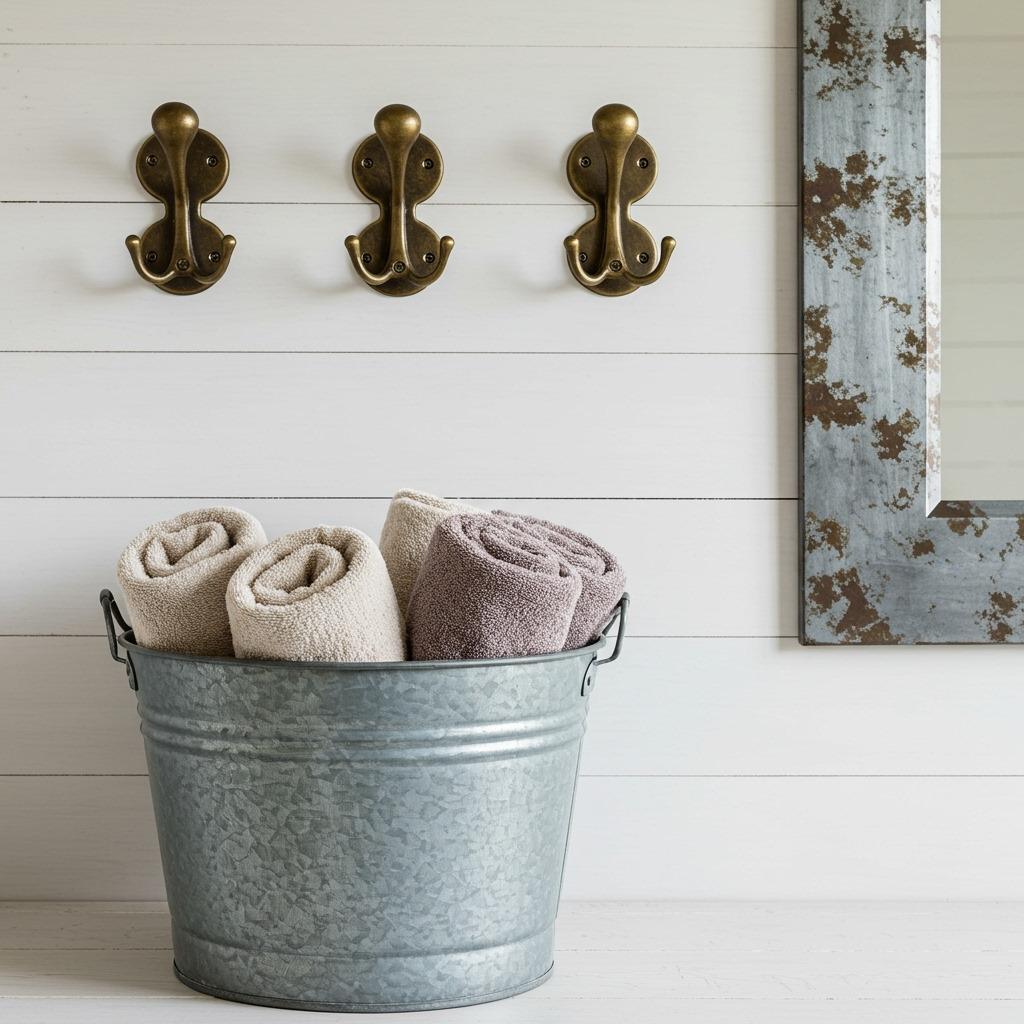
Metal brings that industrial-meets-agricultural quality that defines farmhouse style. We’re talking galvanized buckets repurposed as wastebaskets, wrought iron towel bars with hand-forged details, and aged brass fixtures that look like they’ve been around since your grandparents’ generation. These materials add weight and substance to what could otherwise feel too soft and cottagecore.
The finish matters as much as the metal itself. Shiny chrome reads too modern and clinical for most farmhouse bathrooms. Instead, look for oil-rubbed bronze, unlacquered brass that will develop a natural patina, or genuinely vintage pieces from antique stores and salvage yards. That lived-in quality is what makes metal accents feel intentional rather than matchy-matchy.
Don’t be afraid to mix different metal finishes in the same space. A galvanized mirror frame, brass faucets, and black iron cabinet hardware can all coexist beautifully. The unifying factor is that worn, authentic quality that suggests these pieces were collected over time rather than bought as a coordinated set.
6. Open Shelving with Baskets

Open shelving solves the storage problem while keeping your bathroom feeling airy and uncluttered. Unlike closed cabinets that hide everything away, shelves let you display your prettiest bathroom essentials while keeping everyday items accessible. This also forces you to be more intentional about what you keep and how you organize it, which is usually a good thing.
Woven baskets are your best friend here. They hide less attractive necessities (toilet paper, cleaning supplies, random tubes of product) while adding texture and warmth. Natural materials like seagrass, wicker, or wire baskets with fabric liners all work beautifully. Size them to fit your shelf depth so things don’t look too cluttered or sparse.
Style your shelves like you’d style any other surface in your home. Mix functional items with decorative touches like small plants, a vintage scale, or glass jars filled with cotton balls. The goal is “curated” rather than “perfectly organized,” so embrace a little looseness in how things are arranged. This isn’t a hotel bathroom, it’s a real space where real people actually live.
7. Subway Tile with Dark Grout

Subway tile might seem basic, but pair it with dark grout and suddenly you’ve got graphic interest that elevates the entire space. The high contrast makes the tile pattern pop in a way that white-on-white just doesn’t achieve. It’s also forgiving – dark grout hides discoloration and doesn’t show every water spot or soap splash.
The traditional 3×6 inch size and brick-pattern layout feels most authentically farmhouse, though you can play with different installation patterns for more visual interest. Vertical stack, herringbone, or even a simple running bond with thick grout lines all work. Just avoid anything too trendy like chevron or complex geometric patterns that might feel dated in a few years.
Extending subway tile from floor to ceiling creates a clean, cohesive look that’s especially effective in shower areas. If that feels like too much tile, consider running it three-quarters up the wall and painting above, or using it as wainscoting with shiplap or beadboard above. Both approaches maintain that farmhouse character while breaking up the surfaces.
8. Vintage-Inspired Light Fixtures
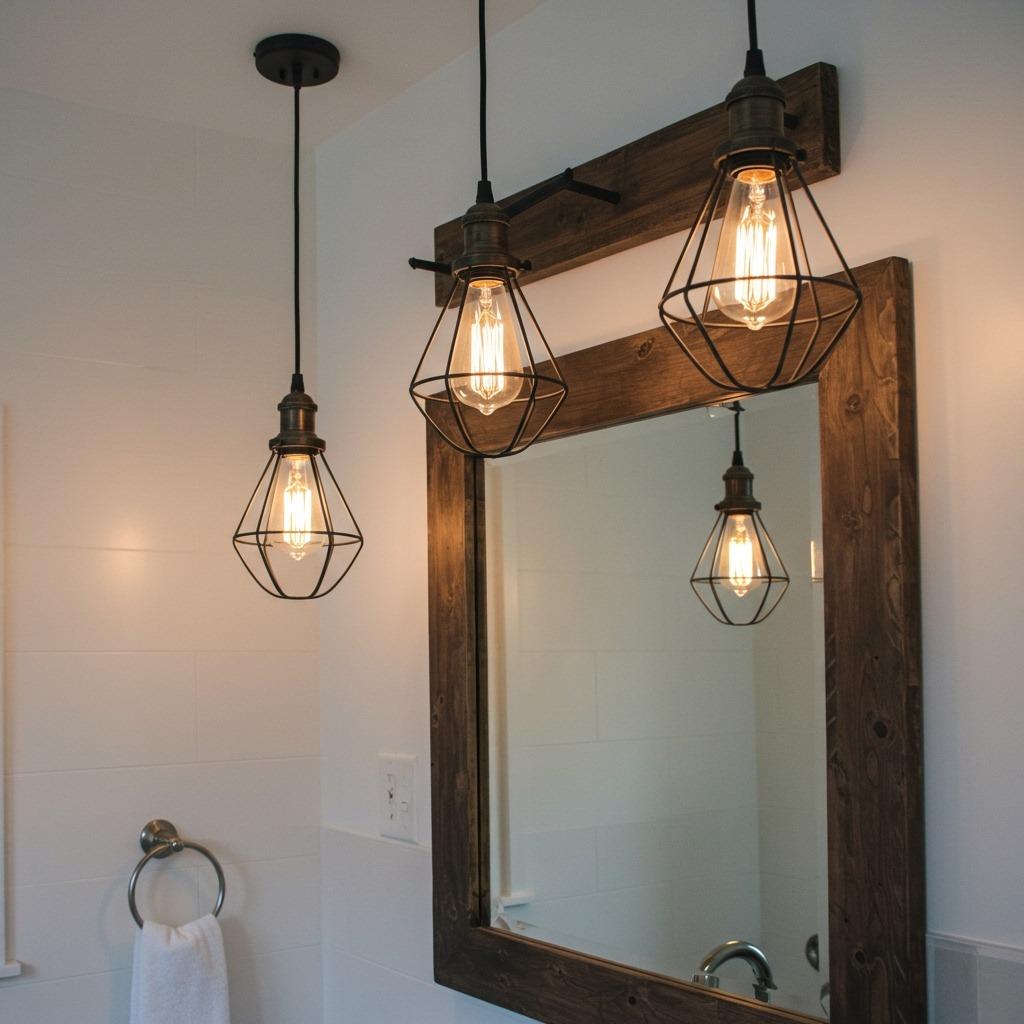
Lighting sets the mood more than almost any other element, yet it’s often an afterthought. Farmhouse bathrooms call for fixtures that feel like they could have been original to an old house – think industrial cage pendants, schoolhouse glass globes, or simple metal sconces with Edison bulbs. These styles provide good light while adding architectural interest.
Scale matters when choosing fixtures. A too-small sconce on either side of a large mirror looks tentative and apologetic. Go bigger than you think you need. Substantial fixtures anchor the space and provide better task lighting for activities like makeup application and shaving. If you’re hanging pendants, make sure they’re positioned at the right height so you’re not staring directly into the bulb.
Don’t forget about the bulbs themselves. Warm-toned LED bulbs (around 2700K) create a softer, more flattering light than the harsh blue-white of cool LEDs. If your fixtures allow it, vintage-style Edison bulbs with visible filaments add another layer of old-world charm. They’re usually not bright enough on their own for task lighting, but they’re perfect for creating ambiance.
9. Natural Wood Ceiling Beams
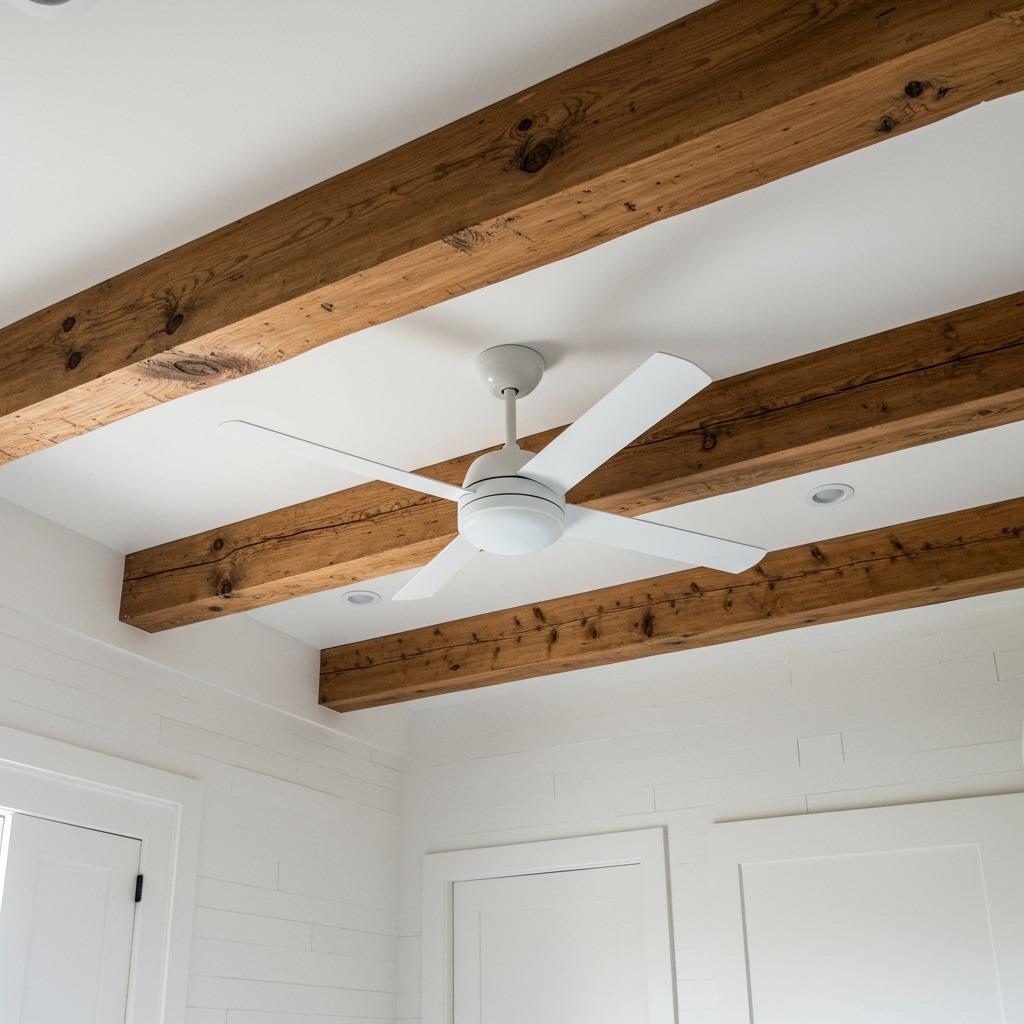
Ceiling beams add architectural drama and draw the eye upward, making your bathroom feel more substantial and finished. Real exposed beams are ideal if you’re working with an older home or doing a major renovation, but faux beams made from hollow wood boxes look surprisingly convincing and are much easier to install. Either way, they break up the expanse of ceiling and add that rustic element farmhouse style craves.
The wood tone you choose affects the whole room’s vibe. Darker stained beams create strong contrast against white ceilings and feel more dramatic. Lighter weathered or white-washed beams blend more gently while still providing texture and interest. Consider your room’s proportions – darker beams can make low ceilings feel even lower, while lighter options maintain the sense of height.
You don’t need beams running every which way to achieve the look. Two or three substantial beams running parallel across the ceiling is often more effective than many smaller pieces that can start to feel busy. The goal is to suggest structure and history, not to recreate an actual barn interior.
10. Antique Mirrors and Frames
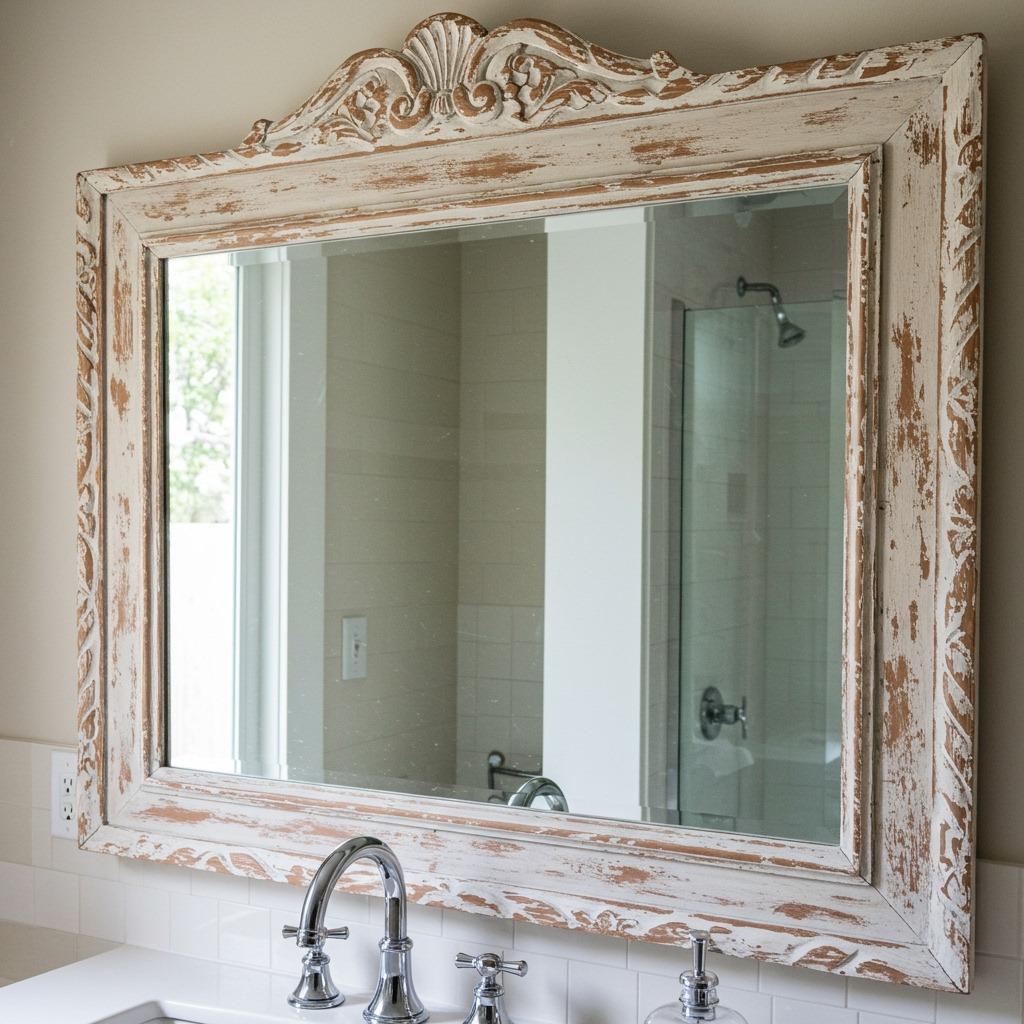
An antique mirror instantly becomes your bathroom’s focal point and conversation starter. Unlike the perfect, beveled mirrors you find at home stores, vintage pieces come with history written into their frames – carved details, original glass with slight imperfections, and finishes that have aged gracefully over decades. These characteristics add soul to what could otherwise be just another functional bathroom.
Shopping for antique mirrors is part treasure hunt, part patience game. Estate sales, architectural salvage yards, and online marketplaces are your best sources. Don’t worry if the frame isn’t in perfect condition – minor chips and worn spots add to the authentic farmhouse aesthetic. You can always touch up the finish if needed, though sometimes the original patina is exactly what makes the piece special.
Size and proportion matter when hanging your mirror. It should be substantial enough to balance your vanity without overwhelming the wall. A too-small antique mirror above a large double vanity looks apologetic, while an oversized piece above a small pedestal sink can feel dramatic in the best way. Trust your eye more than strict “rules” about how many inches above the sink.
11. Sliding Barn Door
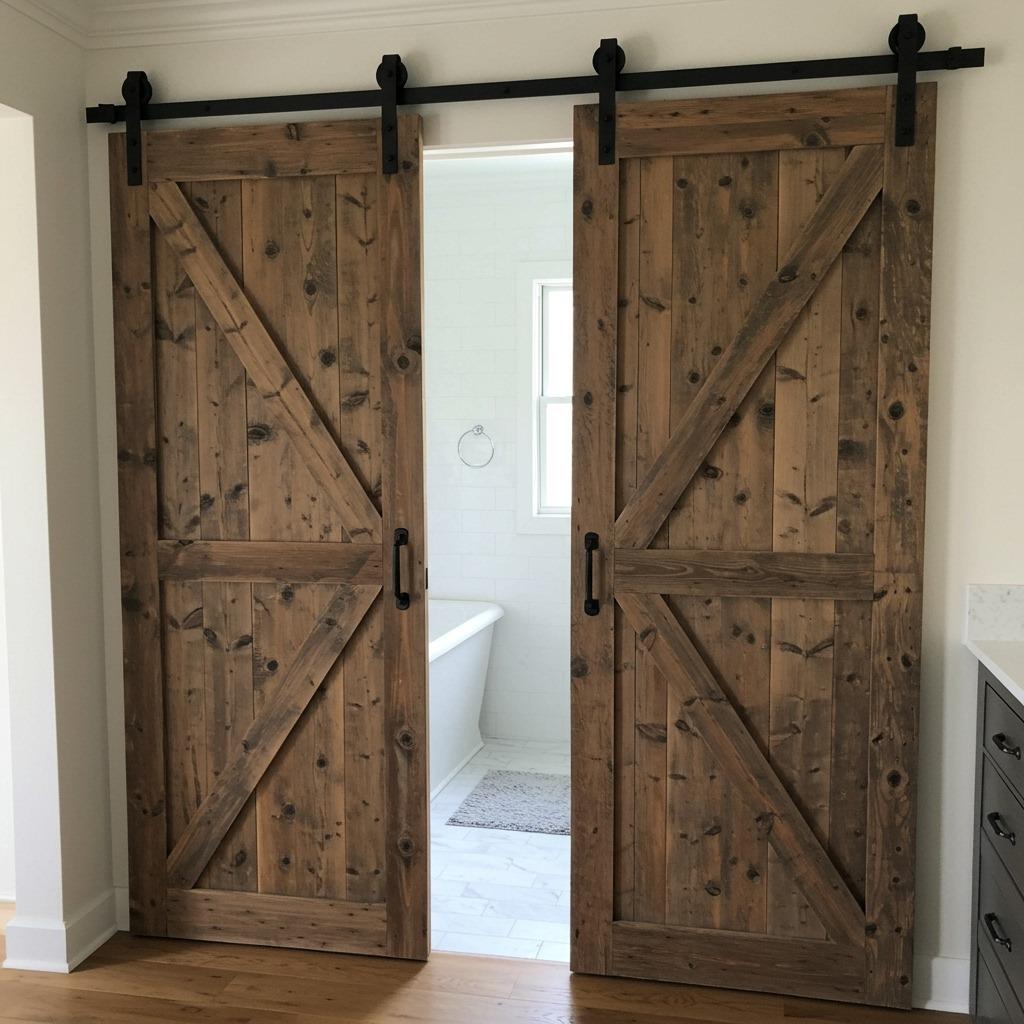
Barn doors aren’t just about aesthetics, though they certainly deliver on that front. They’re practical space-savers in bathrooms where a traditional swinging door would eat up valuable floor space. The sliding mechanism and exposed track hardware add industrial interest while the door itself brings rustic warmth through weathered wood and simple X-brace construction.
You can build a barn door yourself if you’re comfortable with basic carpentry, using new boards distressed to look old or actual reclaimed wood. Pre-made options are widely available now at all price points, from big-box stores to custom artisans. The hardware matters as much as the door – chunky black metal tracks and rollers feel most authentically farmhouse, while sleeker stainless options read more modern.
One consideration: barn doors don’t seal as tightly as traditional doors and offer less sound privacy. This makes them better suited to powder rooms or master bathroom layouts where privacy isn’t as critical. If sound is important, you can add felt strips along the edges to reduce gaps, though it won’t be completely soundproof.
12. White Pedestal Sink
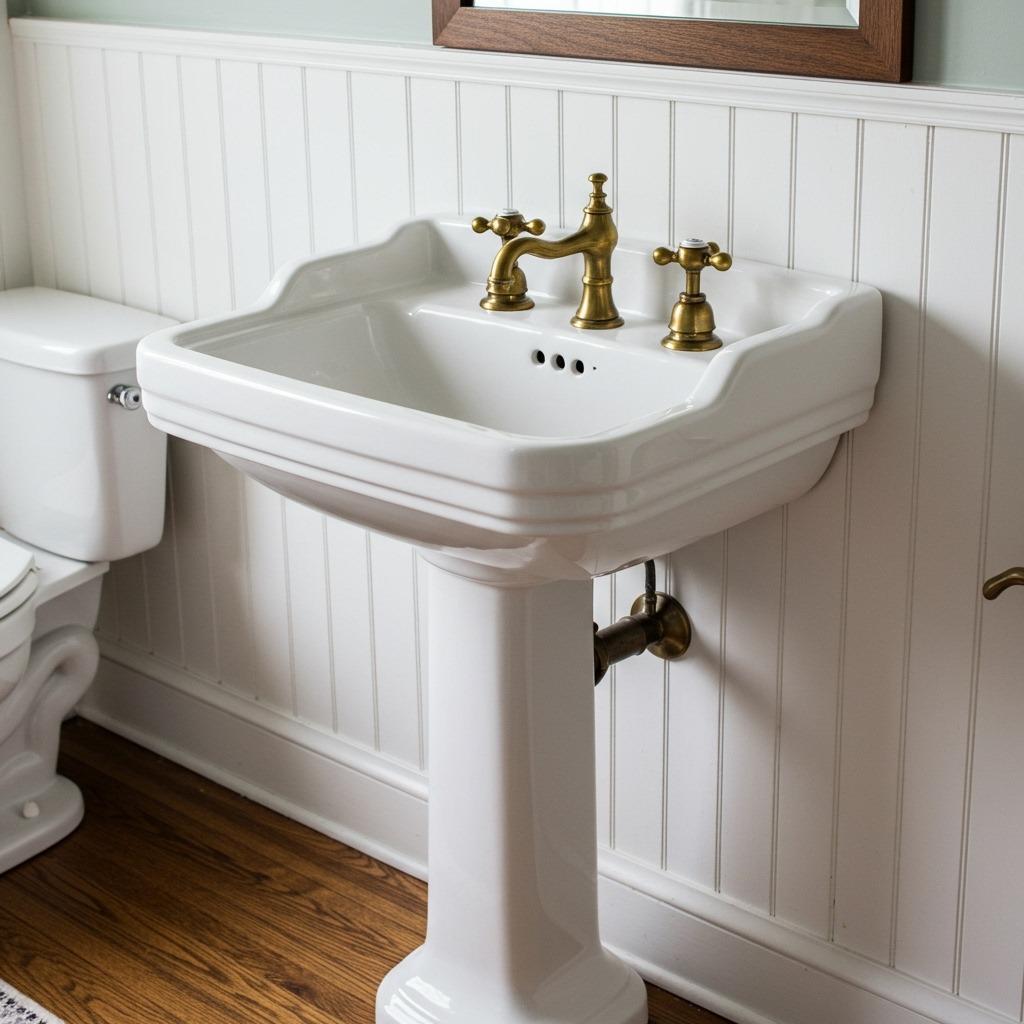
Sometimes simpler is better. A pedestal sink strips away everything unnecessary, leaving just the pure functional form that’s been bathroom standard for over a century. This works especially well in smaller bathrooms or powder rooms where a full vanity would overwhelm the space. The elevated basin and slender pedestal base create visual lightness while the white porcelain feels crisp and clean.
The downside everyone mentions is storage – or lack thereof. You lose that vanity cabinet space for stashing products and supplies. But this limitation can actually be freeing, forcing you to pare down to essentials and find creative storage solutions like wall-mounted cabinets, floating shelves, or a pretty vintage cart nearby. Sometimes working with less makes a space feel more intentional.
Faucet selection becomes more visible with a pedestal sink since there’s no cabinetry to draw attention. Vintage-style cross handles or bridge faucets in oil-rubbed bronze or unlacquered brass complement the traditional form beautifully. Wall-mounted faucets can work too, creating an even more streamlined look that shows off the sink’s sculptural qualities.
13. Beadboard Wainscoting

Beadboard brings cottage charm through its distinctive vertical grooves and traditional wainscoting height. This wall treatment protects your lower walls from moisture and wear while adding textural interest that plain painted walls just can’t match. The vertical lines also create subtle upward movement that can make ceilings feel slightly higher than they actually are.
Installation isn’t terribly complicated if you’re reasonably handy. You can buy pre-made beadboard panels that cover large sections at once, or go with individual tongue-and-groove boards for a more custom look. Either way, you’ll want to add a chair rail cap along the top edge for a finished appearance. Paint everything the same white color for seamless cohesion, or use the horizontal rail as a dividing line between two paint colors.
Beadboard works beautifully with other farmhouse elements we’ve discussed – it pairs naturally with shiplap on upper walls, looks great beneath subway tile in shower areas, and provides a classic backdrop for vintage fixtures and furniture pieces. The style has been around long enough that it feels authentic rather than trendy, which means it’ll age well even as design trends shift.
14. Vintage Rug or Runner
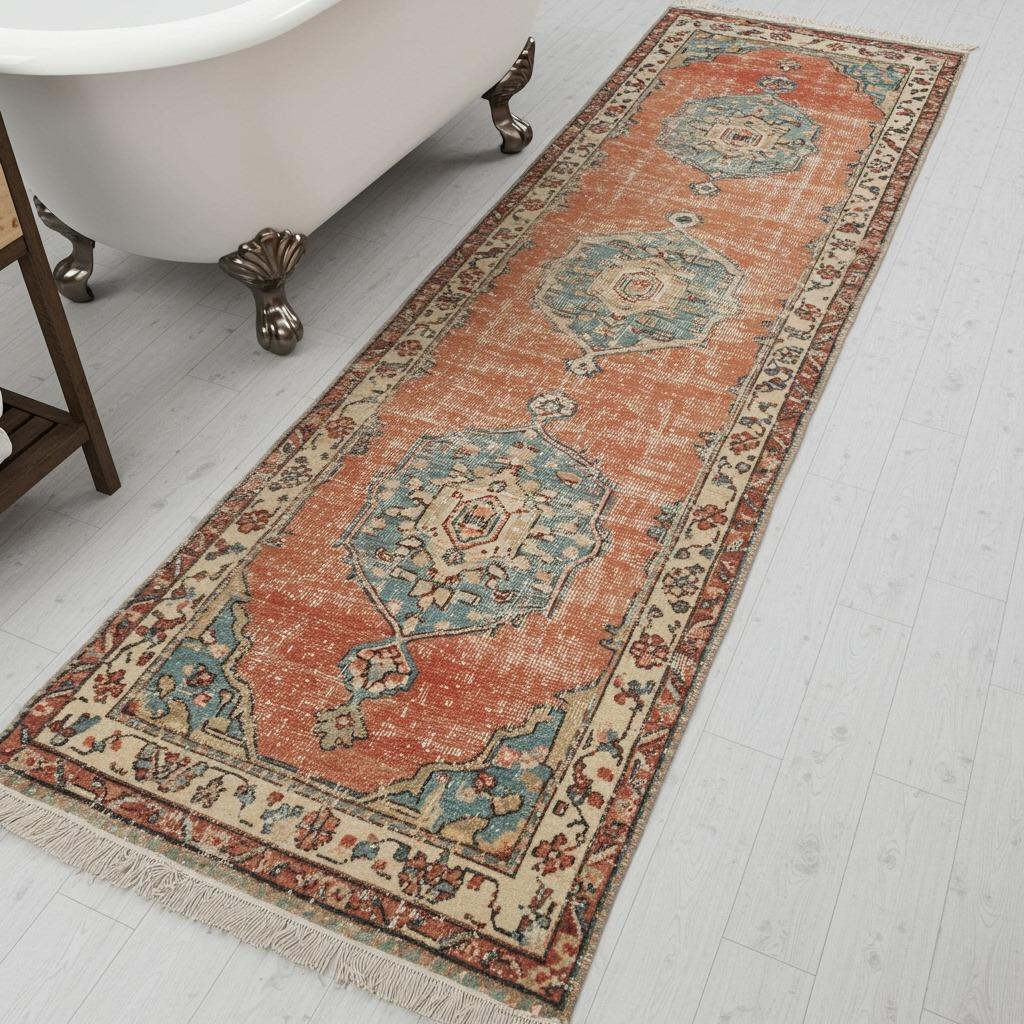
A well-chosen vintage rug grounds your farmhouse bathroom and introduces pattern, color, and softness underfoot. Look for pieces with faded colors and worn spots that suggest age and history – that Persian runner that’s seen better days is infinitely more interesting than a fresh-from-the-factory reproduction. The imperfection is what makes it work in a space that’s all about authentic, lived-in charm.
Practicality matters in bathrooms, obviously. Choose rugs made from materials that can handle some moisture – wool is naturally water-resistant and dries relatively quickly. Turkish and Persian rugs have held up in bathrooms for generations. Just make sure there’s good ventilation so the rug can dry between uses, and consider using a rug pad underneath to prevent slipping and allow air circulation.
Size and placement require some thought. A runner works well in narrow bathrooms or positioned alongside a freestanding tub. A larger area rug can anchor a spacious master bathroom, defining the vanity zone or sitting area. Just make sure the rug’s scale matches your room – a too-small rug floating in a large space looks lost, while an oversized piece crammed into a small bathroom feels claustrophobic.
15. Natural Fiber Elements
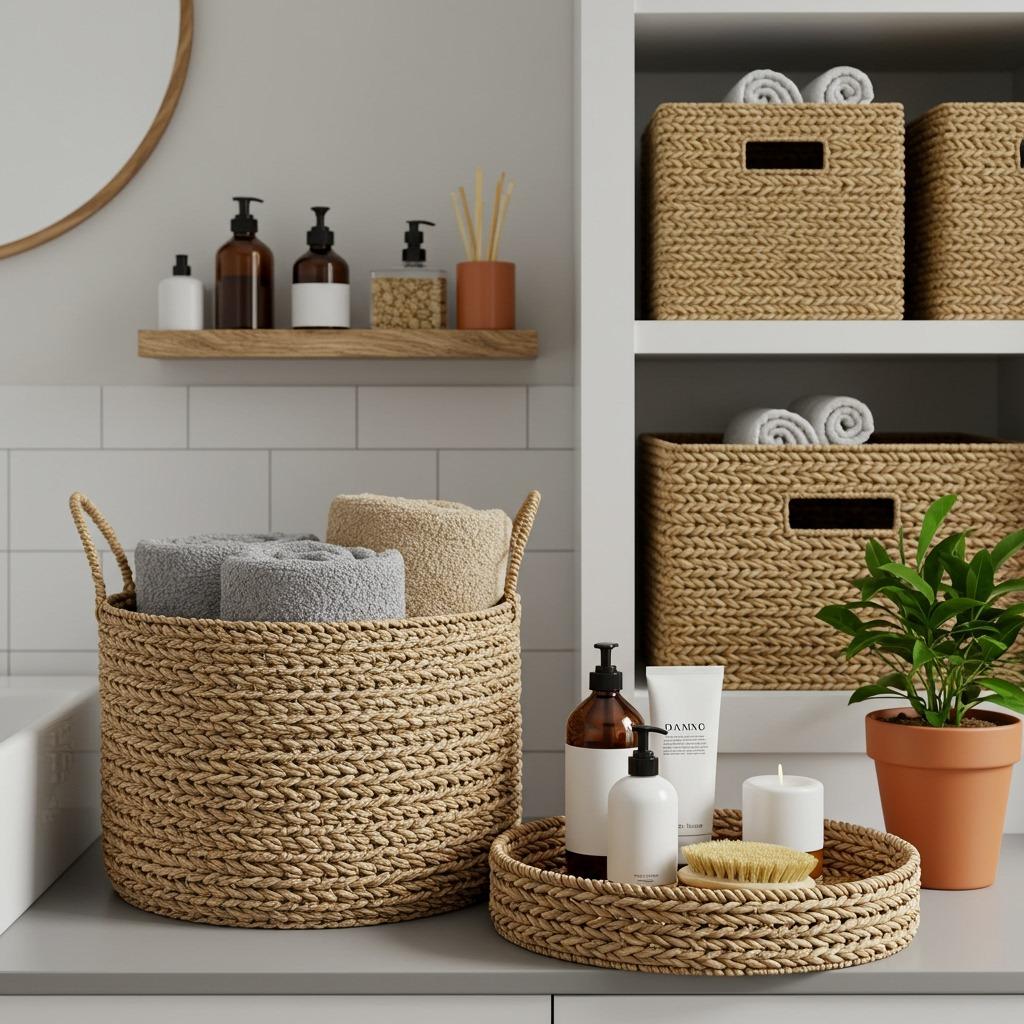
Natural fibers bring organic warmth and texture that soften all those hard bathroom surfaces – tile, porcelain, metal, wood. We’re talking jute, seagrass, wicker, rattan, linen – materials that feel connected to the earth and add tactile interest. These elements bridge the gap between the rough rustic side of farmhouse style and its softer, more refined cottage influence.
Storage baskets are the easiest entry point. Swap plastic bins and wire organizers for woven seagrass or water hyacinth baskets that look good sitting out on open shelves. They hold just as much stuff while contributing to the aesthetic rather than detracting from it. Different sizes can nest together when not in use, and they’re lightweight enough to move around easily.
Don’t stop at baskets. Consider a jute rug if vintage wool feels too precious for your bathroom’s traffic level. Hang linen towels instead of thick terry cloth for a more relaxed European sensibility. Display bath products on a woven rattan tray. Even small touches like these accumulate into an overall feeling of natural, unpretentious comfort. If you’re exploring more home improvement ideas, these natural elements can extend throughout your entire home for cohesive style.
16. Mason Jars and Vintage Glass Containers
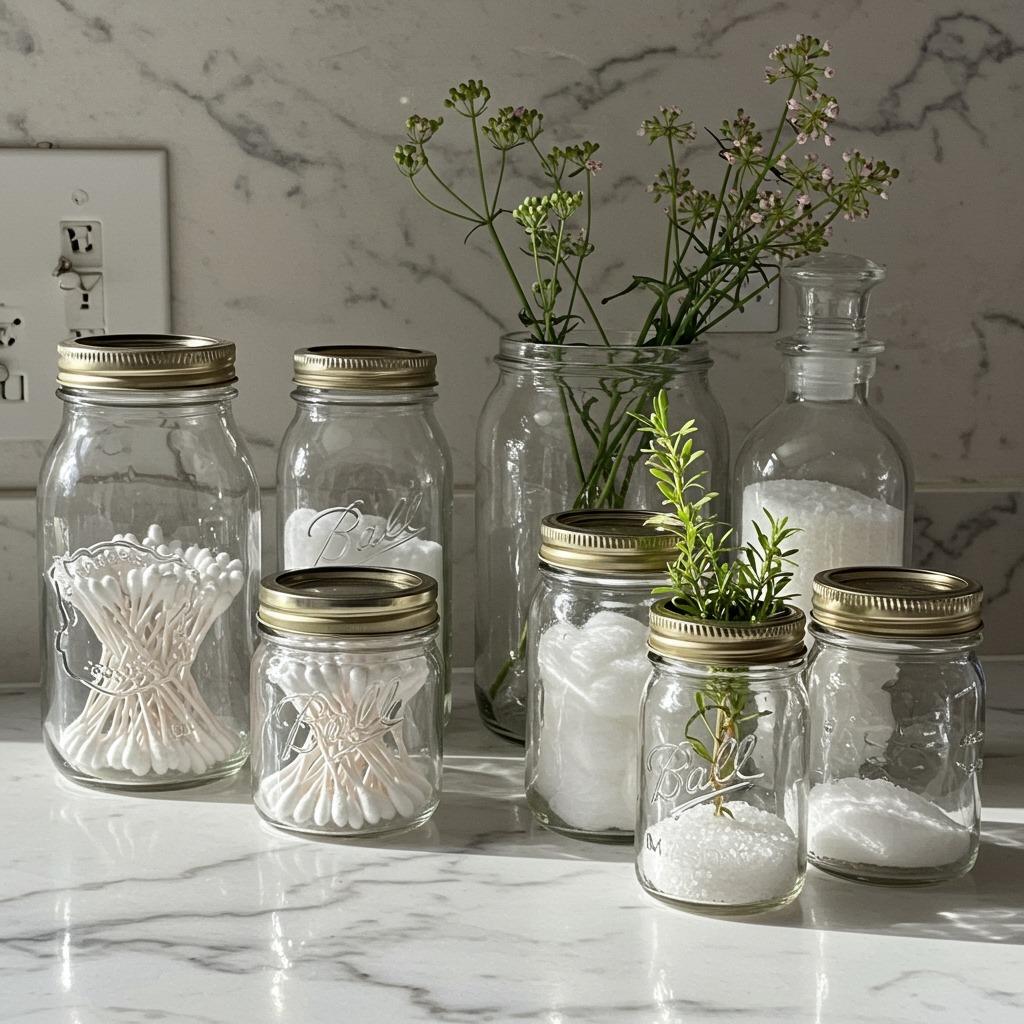
Mason jars have become farmhouse shorthand, maybe even cliché at this point. But there’s a reason they persist – those thick glass walls and simple shapes are genuinely useful and look good doing it. Use them to corral cotton swabs, bath salts, makeup brushes, or whatever small items tend to scatter across your counter. The transparency lets you see what’s inside while the vintage glass adds character.
Beyond basic mason jars, look for antique apothecary containers, old milk bottles, or vintage canning jars with interesting embossed lettering. These pieces often turn up at flea markets and estate sales for just a few dollars. The variations in glass color (some have that pale blue or green tint) and the different embossed designs make each one unique. Group several together for more visual impact than a single jar sitting alone.
Styling matters. Don’t just plop things in jars and call it done. Consider what you’re storing and how it looks through the glass. White or neutral items (cotton balls, Q-tips, bath salts) look cleaner than random colorful products. Leave some jars empty or filled with simple stems cut from your yard. The goal is functional beauty, not just storage-in-glass-instead-of-plastic.
Bringing It All Together
Creating a farmhouse bathroom with genuine rustic charm isn’t about checking every box on a decorating list. It’s about choosing the elements that speak to you and weaving them together in ways that feel natural and unforced. Maybe that’s shiplap walls with a vintage mirror and some well-placed baskets. Or perhaps you’re drawn to the cleaner lines of subway tile and a pedestal sink with just a few weathered wood accents.
The beauty of country bathroom decor lies in its flexibility and forgiving nature. Imperfections aren’t flaws to hide but character to celebrate. That slightly uneven shiplap installation? It looks handcrafted. The vintage mirror with some silvering worn away? It has history. The mixed metal finishes that don’t quite match? They look collected over time rather than bought in a single shopping trip.
Start with one or two foundational elements – maybe that farmhouse bedroom themes inspired apron-front sink you’ve been eyeing, or the reclaimed wood vanity you found at a salvage yard. Build around those pieces gradually, adding layers of texture and vintage charm as you find items that feel right. The best farmhouse bathrooms evolve over time, just like the authentic old homes that inspired this style in the first place.
What matters most is creating a bathroom that makes you happy every time you walk in. A space that feels warm, welcoming, and completely yours. Where the morning routine becomes a little more pleasant and evening baths feel genuinely restorative. That’s what good design does, regardless of style. The farmhouse aesthetic just happens to be really good at delivering that comfortable, lived-in feeling we all crave.



